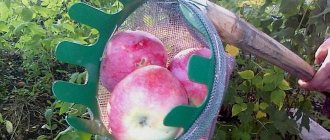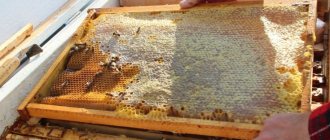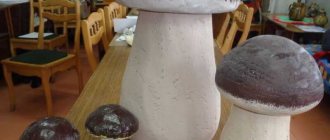Wild forest berries are good for health and contain a rich set of vitamins, but picking them by hand is a huge physical labor that requires good health and a lot of free time.
A simple device for picking blueberries, which I show with three simple designs, can reduce the load on the body and significantly speed up this process.
Their design, materials and manufacturing technology are different, which affects the process of harvesting berries. Therefore, get to know everyone and choose the option that suits you best.
How to choose?
Choose according to the size of your plot or forest in which you will pick berries.
If you plan to collect fruits only for eating or making jam, then you should not spend money and purchase a whole combine or vacuum collector. A simple hand tool will suffice. It can also be customized to the types of berries you want. In fact, even with a manual unit you can pick different types of berries. For example, if you grow cranberries, then it is better to purchase a tool whose partitions are made of solid metal. Because of this feature, there will be no tangling of plants.
A vacuum collector will help you collect berries such as gooseberries, wild raspberries, strawberries, wild strawberries, currants, lingonberries, cranberries, sea buckthorn and many others. You can even collect hazelnuts.
Pay attention to the price too. A vacuum berry picker costs about 29 thousand
rubles and is intended for those who make fruit picking their business. Of course, it’s worth remembering the price of a mechanical harvester, namely 1-9 million rubles. This is a high price for a medium-sized plot of land.
Varieties
There are three types of berry harvesters: mechanical, vacuum and manual. They differ in operating principle, performance, and drive used. Mechanical berry pickers are used on farms for the industrial cultivation of fruit bushes. For one-time use, manual or vacuum designs are suitable. They are compact, lightweight, and can be used in any conditions.
Mechanical
Active harvesters are considered industrial special equipment designed for collecting berries on large plantations. According to their layout, mechanical assemblers can be self-propelled or trailed. The first are represented by independent devices assembled on a wheeled chassis. They are equipped with an internal combustion engine, transmission, and actuators. The working body, the comb, is designed to collect a certain type of berries, which forces the device to be reconfigured for different crops.
Towed mechanisms only work in conjunction with a traction machine. The working bodies receive rotation from the power take-off shaft located at the rear of the tractor. Trailed structures cost less than self-propelled ones due to the simplification of the device, the absence of an engine and transmission. The functionality of the units is identical: they can collect berries of different sizes, growing at any height.
Expert opinion
Stanislav Pavlovich
Gardener with 17 years of experience and our expert
Ask a Question
Interesting! Mechanical pickers do not pollute the earth. Grass, leaves and branches captured along with the fruits end up in a storage hopper.
Vacuum
To facilitate manual assembly, we developed a mobile complex that allows us to speed up the process and reduce physical stress on the user of the device. The vacuum berry picker is made in the form of a backpack that is worn on the back. It consists of a gasoline engine, a storage container, and a socket with a comb nozzle. The picking of blueberries or other fruits occurs due to the air flow, which captures the berries, carrying them into the hopper. The manipulator tube allows you to increase the grip area, eliminating frequent operator movements.
See also Features of blueberry growth, how to plant and care for it
Manual
Elementary devices consisting of a comb, container and handle are used in a private area or when collecting wild berries. They are made from plastic, metal or wood. Assemblers appreciate models from Finnish manufacturers: they are made of durable materials, which eliminates breakage and ensures long service life. Garden centers offer solid plastic structures. They weigh little, are not subject to rotting and corrosion, but are sensitive to mechanical stress.
Classification of berry harvesters
Based on the level of mechanization, all berry harvesters are usually divided into:
- Manual without mechanization of processes. The designers were inspired to create them by ancient prototypes that have been used on our lands since time immemorial, their appearance reminiscent of a short-handled rake with a bag or box tied to it. Nowadays these are very ergonomic containers with a handle, equipped with a wire or sheet palisade to grip stems or branches;
- Manual with mechanization of processes. On the modern market there are products held in the hand that use a motor for frequent translational movements of the removing block to crush the berries from the branch, or vacuum suction; 3. Automatic under operator control. Outwardly they resemble ordinary forage or grain harvesters, with the difference that they do not have mowing blocks or digging elements. And separation processes, taking into account the fragility of the product, have their own characteristics.
Based on available assembly volumes, industrial berry units and devices for home use and small farms are distinguished.
How to make a harvester for collecting lingonberries and other berries with your own hands?
It’s easy to make a manual harvester yourself using the following drawings:
Materials you will need:
- metal wire;
- wooden slats;
- Sheet steel;
- pieces of plywood or plastic;
- fasteners.
The production process itself is as follows:
- Patterns are made from paper of all parts except wire ones;
- Using metal scissors, the bottom of the device and its body are cut out of a sheet of steel;
- On a separate narrow sheet of galvanized steel with a width equal to the size of the berry receptacle, one edge is bent - the future cutter;
- In the second part of this piece, holes are drilled every 0.4-0.5 cm, the diameter of which is equal to the diameter of the wire;
- The wire is cut into segments 10 cm long (the size of the wire should not exceed 0.3 cm), and inserted into the prepared holes, after which it is fixed by welding, bending the plate with a hammer, a wooden lath or any other convenient method;
- The ends of the resulting rake are bent with a side to protect the berries from rolling;
- The body is assembled using the selected fasteners, and the rake part is screwed to it. You can additionally cover it, for example, with wood or plastic for the safety of hands and plants;
- The handle can be made by bending a tube or double narrow plate from galvanized steel. You can also use any analogue that is idle on the farm (a door, a construction iron, etc.). It is attached by welding to the metal top of the structure or with bolts, for which holes must first be drilled.
To give the handle anti-slip properties, you can wrap it with electrical tape.
Thus, making a berry harvester yourself is not at all difficult, and cheap and affordable materials, as well as tools, will be used for this.
The only note: the dimensions of the container depend on the planned collection volumes, but here it is important to look for a proper balance between them and the convenience of holding the entire structure by hand, as well as the characteristics of crop growth
Required tools and materials
Do-it-yourself berry harvesters are made from plastic bottles, cans, plywood, and metal. The set of tools required for the job determines the material. When working with galvanized steel and wire use:
- hammer;
- metal scissors;
- welding or tin, flux and soldering iron for soldering;
- emery wheel;
- drill;
- chisel;
- pliers.
To build a harvester from wood (plywood) with your own hands, you will need a circular saw or jigsaw, a grinding machine or sandpaper, self-tapping screws, a drill, and PVA glue. The easiest way to work is with plastic. To work with this material, a knife and scissors are enough.
Drawings and dimensions
For blueberries, gooseberries, cranberries and lingonberries, the simplest ladle with a recess is suitable. A comb with teeth 10–15 mm long, which are spaced 4–5 mm apart from each other, is attached to the front. The back of the bucket is equipped with a handle for more convenient operation. The berries are easily picked from the bush and rolled into a container, and then they can be poured into a bucket or other container.
The parameters of such a berry picker will be as follows:
- base in the form of a rectangle with sides 72 and 114 cm;
- sidewalls that bend U-shaped according to the drawing below;
- comb teeth 2 mm thick and 10 mm long;
- the distance between the teeth is 5 mm.
Figure 1. Drawing of a metal berry picker
This is due to the fact that their leaves are too large and do not fit well between the comb teeth. It is recommended to collect strawberries on a large scale using commercial berry pickers-vacuum cleaners, which cause minimal damage to the delicate trunks and tendrils of the plant.
Was the robber invented by a bear?
We do not know when and who figured out to carve the first such instrument from wood, but we can guess who inspired this person. Most likely a bear. Berry places attract this gourmet, whose clubbed limbs are quite capable of feeding the voracious forest hero. He manages them very deftly - he catches fish in the rapids, eats oats, and picks berries. It’s not for nothing that those bears that get into the habit of sown fields are called fescue bears. An eyewitness describes: “He sat down on his butt, put his paws into the oats and slashed up the stem with his claws, scooping all the oats into his mouth.” The same with berries: it’s not for nothing that the long teeth of a rake are so similar to the clawed paw of a bear
Careful handling of rakes made it possible to take care of the berry lands. In order not to harm the plant, the “claws” were carefully threaded through the branches of the berry bush near the ground and shook slightly so that the berries fell off and the leaves were not damaged.
The shape of the instrument carved from wood depended on the imagination and diligence of the master. The rakes could be very simple, utilitarian, or intricately decorated with paintings or carvings.
How and when to pick blueberries without damaging the berry plant: personal observations
I live in the middle climate zone, and I judge the beginning of blueberry ripening by observing the black currant fruits in the country. As soon as they begin to turn from brown to black, you can immediately head to the forest.
This usually happens at the end of the first week of July. At this time, the blueberry is not yet fully ripe; there are many small and green berries. It is not worth collecting them with mechanized devices: there is a lot of waste.
The leaves (like the fruits) stick very firmly to the bush and, when they get between the teeth, they crush and deform the berries, and when they come off the branches, they make picking very difficult. The garbage becomes saturated with juice and is difficult to separate.
During this period of time, I recommend abandoning any mechanisms and picking berries only with your hands. My speed is low: on average, I get a little more than 1 liter per hour, but it’s quite enough for home preparation and consumption, and I’m not involved in sales.
At this time, the collection is accelerated:
- a container for berries, made on the principle of a sippy inkwell, the ribbon of which I hang around my neck;
cups on the fingers of each hand, saving the movement of the berry picker’s hands towards the container.
I consider the optimal time for harvesting with mechanized devices to be the end of July and August: blueberries are gaining strength, and the fruits, reaching their maximum size and the greatest amount of vitamins, have a pleasant taste.
It is during this period that I make my mechanized devices. Nowadays it’s not a problem to buy a factory-made blueberry harvester. But it is prestigious for a home craftsman to do it with his own hands, taking into account his individual abilities.
In this case, it is necessary to take into account a number of technical features that take into account the physical properties of the ripe berry. I include:
- fruit size;
- separation force from the stalk;
- the state of the juice and the crushing strength of the shell;
- presence of garbage.
How does fruit size affect puller design?
A ripe blueberry usually exceeds 6 mm in diameter.
I take this indicator into account by the gap between the teeth of the combine, choosing it to be at least 5 mm. It allows:
- cut off some of the underdeveloped fruits, leaves, needles, and other debris;
- collect only ripe varietal berries;
- do not damage the bush.
Which tooth shape is safer to tear blueberries from the stem?
Among industrially produced combines, designs with teeth made of round wire predominate.
It is more convenient to make them this way, but this does not have a very good effect when the berry is torn from the stalk. I showed this process in the figure. I share my observations.
At the round tooth, the fruit is pulled into the recess shown by the dotted lines and is slightly crushed. A flat surface immediately tears the berry away from the stalk, deforming it less.
In this case, it is important to avoid sharp edges at the ends, which can push through the thin shell. I do this by forming a very small chamfer on the ribs.
The width of the tooth also affects the operation of the device. A narrow profile fits better between twigs and leaves and creates less clustering. This reduces the formation of debris in the gaps and does not injure the ripened fruits and the blueberry itself.
Types of rakes
In order for the work carried out on the site to be as efficient as possible, but with minimal effort, you need to use different types of rakes for their intended purpose. Straight rakes are the most versatile type. In this type, the teeth are located perpendicular to the handle, slightly bent inward. They fit perfectly:
- for raking leaves;
- loosening the soil;
- leveling the ground after digging;
- extracting the remaining roots.
Among the traditional types, rakes with twisted teeth are distinguished - they break up piles of earth better and fluff up the soil well. Homemade wooden rakes usually have a wide base with short teeth. Their main purpose is to remove dry weeds and mown grass. For this species, wooden or aluminum cuttings are often made.
A fan rake consists of a base that resembles an open fan. The teeth are long thin rods bent at the ends. Often such rakes are used:
- for raking leaves and small debris from hard-to-reach places;
- cleaning the lawn before mowing;
- thinning the lawn.
When choosing a fan rake, it is worth considering some design features: in order not to injure young plants, it is better to use equipment with plastic teeth; for work along fences and in corners, triangular rakes, etc. are perfect. In agriculture, there are also different types of rakes, depending on the features of the mechanisms:
- tape;
- wheeled rake-tedders (GVK);
- wheel-finger, which also belong to the GVK;
- transverse, etc.
Among the units of the GVK class, experts call the following models the best: GVK-6, GVK-7, GVK-3, GVK “Solnyshko”, GVK-2.5KT. In particular, GVK-6 perfectly rake dried grass, hay and straw into windrows of a certain size, and also ted the swaths so that the grass mass is collected into an airy, non-twisted windrow. The principle of operation of the GVK is that while the unit is moving, the impellers rotate and move the grass with the fingers to the length of the wheel grip. After all the wheels have passed, the hay moves to the central axis, thus forming a windrow. Many craftsmen now make such units with their own hands, adapting equipment, terrain, crops grown, etc. to their needs and characteristics.
Advantages and disadvantages
The big advantage is that it simplifies collection and increases the speed of work. Even homemade units will allow you to work several times faster, and in 7-8 hours a novice assembler will be able to collect 12-15 kg. Very impressive numbers when compared with the bare-handed collection method.
Another plus is the low price. On average, berry pickers cost about 900 rubles. You can recoup this price on the first day or after several hours of work. You can make such a unit yourself, but for this you need to try.
The disadvantage of using a combine is the damage to berries and bushes. The thing is that when you pick leaves and young branches along with the berries, you make the bush less fertile. Such a sharp method of plucking has a bad effect on what the harvest will be like next year. In addition, you litter with leaves and debris that falls to the ground from branches.
Rating of fruit pickers in the form of a bowl
This is the most popular and widespread version of the collector among summer residents. The devices are usually equipped with sliding rods and wooden handles of various sizes.
Park 90482
Plastic fruit picker in the form of a 16 cm high bowl framed with petals. Can be attached to a wooden or plastic handle. The captured fruits are picked by rotating the product around its axis and trimming the stalk with petals.
Advantages:
ease of use;
Flaws:
flimsy construction material.
Reviews:
| Victoria Semyonova | Roman Dalmatov |
| “The product is comfortable to use, but it broke quickly - the plastic is quite fragile.” | “Cheap and functional device. You can buy several pieces at once in reserve. It's a pleasure to work with him." |
NN MI 64436
Basket-shaped attachment with 8 sharpened cutters for removing fruit from trees. Made of plastic, supplied without rod.
Advantages:
- low cost;
- careful action.
Reviews:
| Konstantin Muravyov | Olga Akulich |
| “A necessary thing, it grabs two apples at a time. It’s easy to choose a suitable cutting.” | “We purchased this tool for the garden. It costs a penny, but the benefits are enormous; it harvests carefully, without harming the tree.” |
Comparative characteristics of models
| Model | Park 90482 | NN MI 64436 |
| Assembled cutting | No | No |
| Diameter, cm | 11 | 13 |
| Material | Plastic | Plastic |
| Price, r | 41 | 29 |
Picking berries by hand
Unfortunately, the remoteness of the berry patches significantly complicates their collection. Swampy terrain, forest wilds, mosquitoes and midges also do not add pleasure to this process. But the main difficulty lies in the size of these berries; it rarely reaches 10 mm, and in the northern regions it is even less. Historically, picking wild berries was done by hand, so the fruits are less damaged and fewer leaves and twigs end up in the baskets. However, this method has very low efficiency; even an experienced berry grower in a good year may need more than one hour to fill the coveted bucket. A less agile picker would hardly fill a bucket in a day.
Finnish manual harvester for picking blueberries and other berries
A very convenient hand-held device was invented in Finland, the design of which is certified in many European countries as environmentally friendly. It represents:
- a plastic container (similar to a closed, very large scoop);
- rubberized comfortable handle;
- metal berry cutter;
- protected spokes.
The latter can be bent with a pin, or have plastic limiter balls at the ends. In practice, these knitting needles pry up a branch with berries until they meet the cutter, then they are torn off the base and shaken into a container.
This design does not damage the bushes of berry plants, and the debris accompanying the collection is easily removed by sifting through the sized cells of a special sieve.
Tin ladle: design
If you opt for the metal option, then it is best to prepare a piece of galvanized or sheet aluminum for the job. These materials are quite easy to process and are not too susceptible to corrosion.
You can find many examples of what a cranberry harvester looks like. Photos from this article may also be useful. For example, you can use the template below.
The entire structure consists of a handle and a collection bucket. The bucket, in turn, consists of four more elements:
- body (scan below);
- stiffener;
- comb;
- fastening bar.
What is such a combine?
Structurally, a lingonberry harvester is a deep bucket, to which a special comb with long teeth is attached in the front part from the bottom, and a handle for holding the entire device is located on top.
The disadvantage of this model is the thin metal handle, which is uncomfortable to hold and quickly rubs calluses.
The main working body of such a device is the comb. The length of its teeth is 10-20 cm, so that in one movement you can grab and “comb” an entire lingonberry bush. The distance between the teeth is approximately 4-5 mm. It is into such gaps that the leaves and stems of the bush easily fit, but the berries no longer fit.
Practice shows that a lingonberry harvester is also suitable for harvesting cranberries, bearberries, as well as large blueberries and blueberries. Small blueberries fit between the teeth and are easily crushed. Other berries - strawberries, cloudberries, currants - cannot be harvested with such combs, since the leaves of their bushes are very large and do not fit between the teeth.
The receiving compartment of the device is blind; berries picked with a comb accumulate in it.
When working, the picker holds the scoop in his hand, brings the comb to the base of the bush and simply lifts it up. Stems, branches and leaves pass between the teeth, and the berries are torn off and rolled into the depths of the receiving chamber. At one time or another, the picker pours the berries from the harvester into a bucket or basket.
This way you can pick berries from one bush in a few seconds. When collecting manually, the same operation takes at least a minute.
In well-designed harvesters, the comb does not have sharp cutting edges and therefore does not scratch the plant stems or tear off leaves. Even the edges of the teeth are rounded and do not scratch the stems. That is, in a good case, the tool is harmless to lingonberry bushes. In many cases, when such devices are made by hand, they contain areas that are dangerous for plants, which cause damage to the bushes.
Such devices are manufactured by many manufacturers and, therefore, have different appearance and design features.
For example, Finnish MARJUKKA combines are very famous in Karelia and the Leningrad region. They are made of durable plastic and therefore are quite lightweight, but at the same time durable. The photo shows a classic version of such a device:
And here is a model for children in the form of a fox:
Its price is the same - 750 rubles.
Simpler devices can be made of steel:
and sometimes they don’t even have teeth, but simply a rounded lattice in the front part:
These are the models that are considered the safest. Already these options:
...they pick off a large number of leaves that do not fit between the teeth. It is these harvesters and their analogues that are considered poachers and it is with them that the Ministry of Natural Resources is fighting. And they are the ones that cost less (in the range of 300-400 rubles), which is why they are most popular among the population.
And on cranberry or blueberry plantations, real mobile harvesters are used:
Actually, these manual deep buckets with handles are also called manual harvesters. However, other devices for picking berries, often not at all similar to buckets, work on a similar principle.
Device for collecting rose hips
Rose hips sit tightly on the branch and are difficult to tear off. An ordinary comb will not work. To make a harvester for collecting rose hips with your own hands you will need:
- a piece of plastic sewer pipe;
- blades from a construction knife;
- knife;
- insulating tape;
- pipe plug.
The device can be made in two ways.
First option
Take a gray sewer plastic pipe with a diameter of 150-160 mm. Cut a piece to the required length. The size of the device depends on the preferences of the fruit picker, his height and strength. Make 3 deep slits of the required width from one edge.
Device for picking cranberries while standing
Such a device can be made by a master who is fluent in tools. It is quite complicated, but you can use it to pick cranberries without bending over. All the parts of the box are cut out from a piece of thick plywood, as well as the comb strip.
The comb is easy to make:
- a number of holes are drilled in the plank;
- cut the wire into pieces of the required length;
- the teeth are fixed in the holes with glue.
Note! To prevent the cranberries from spilling out during harvesting, install a movable plate.
The back wall of the bucket is made composite, the lower part is movable. It is attached to the top part on furniture hinges, and fixed to the side walls with pieces of rubber. This design allows you to stand and pour cranberries into a bucket.
To do this, one end of the rope is attached to the lid, the other is tied to a movable handle, which is bolted to a high handle made of 2 plastic tubes. Their length is determined empirically to make it convenient for the assembler.
Wooden choppers are hammered into the holes of the tubes, and plywood plates are screwed onto screws on the outside. The tubes are attached to the box using furniture corners and bolts. The connection turns out to be movable, which is very convenient when picking blueberries while standing. A narrow strip of plywood - a handle - is screwed to the top of the tubes. It is wrapped with soft cloth and electrical tape.
Vacuum cleaner for collecting chokeberry
You will need a corrugated hose from an old vacuum cleaner, a plastic beer bottle with a long neck. It needs to be cut so that there is a piece left for joining with the corrugation. In the lower part of the cylinder, cut a window in which the lower edge is decorated with teeth.
Cutting teeth is difficult; you need a sharp knife. Assemble the combine:
- insert a cylinder with a jagged window into one end of the pipe for collecting berries;
- Secure the joint with several turns of electrical tape;
- Attach a T-shirt bag to the second end of the corrugation with electrical tape.
Comment!
The T-shirt bag needs to be intact, without holes. Picked berries will fall into it.
The operating instructions for this vacuum cleaner are simple. Hold the branch with one hand, and use a ladle to pick off the chokeberry fruits with the other hand. They will roll down the hose into a bag.
What is a blueberry harvester?
Before you make a device for harvesting blueberries, you need to understand what it is. A berry picker is a device that makes harvesting ripe berries much easier. With the help of such a combine, the harvesting procedure does not last several hours, but a matter of minutes.
The main element of this tool is the elongated teeth, which are shaped like ridges. The distance between the cloves is 5-8 millimeters, and the length of each of them reaches 25 centimeters. These sizes allow the comb to safely pass by the leaves and stems of blueberry bushes.
The next important detail of the product is a ladle equipped with a small handle. When harvesting ripe berries, the comb is positioned so that the teeth point upward. Then the structure is carefully pulled along each row. All berries will be automatically picked by the tines and placed in the bucket.
Shutter Tool Options
Plastic scoops with a comfortable handle that allow you to carefully collect small berries without damaging the bush.
Cicle Beetle 4607156361335
Fruit picker for collecting wild berries using a special comb. The flap prevents the accumulated product from falling out.
Advantages:
rounded teeth for gentle picking.
Reviews:
| Irina Ernitskaya | Maria Polovtseva |
| “A handy thing for quickly picking berries. Easy to clean." | “The product is made of high-quality plastic, holds tightly. If you get used to it and pass the branch sideways correctly, the berries will be harvested well and quickly.” |
Park
A device for collecting various berries from bushes: lingonberries, cranberries, blueberries. The product is made of plastic and equipped with a damper. Holes in the bottom allow you to get rid of small debris and leaves.
Advantages:
- strong plastic;
- ergonomic shape.
Reviews:
| Leonid Akimichev: | Pyotr Krakhmalev: |
| “I purchased a model for blueberry bushes. The scoop is inexpensive and high quality, holds the berries well.” | “It’s a lightweight tool, thanks to the flap you don’t have to worry about accidentally turning it over – the contents will remain in place. Significantly saves harvesting time.” |
Comparative characteristics of models
| Model | Cicle Beetle 4607156361335 | Park |
| Length, mm | 230 | 235 |
| Width, mm | 150 | 146 |
| Material | Plastic | Plastic |
| Price, r | 250 | 350 |
When choosing a fruit picker for the garden, you should take into account the type of fruits and berries that you plan to collect. For tall trees, you should choose models with telescopic rods of optimal length. It is better to give preference to products with a safer and more gentle plastic design to avoid damage to the branches.
Details
The combine will consist of two side parts, a bottom with teeth, a back part and a top. It is also worth installing a partition that will prevent the berries from falling out.
The lower part will be rectangular. Cuts are made on one edge with a circular saw. Their length should be about six centimeters, with a gap of five millimeters between the teeth. If you have a grinding machine, you can make an improvised bend of the teeth.
The sidewalls must have one oblique cut. The bottom part will be longer than the top. Next, the lid and rear wall are made according to the dimensions of the combine.
In order for the collected berries to remain inside the device, it is necessary to install a latch on the front wall. It can be made from soft iron, plastic or rubber. This part is mounted on bolts in such a way as to be able to open. The back should also open so that the berries can be unloaded into the container.
Similar designs: rakes, scoops, shovels, combs and others
The principle of “picking” berries from herbaceous bushes is implemented in some devices, either simpler in design, or designed to further simplify the work of the picker.
For example, the simplest options are ordinary wooden scoops with long teeth on the leading edge:
Some of their options are simplified as much as possible:
And some homemade models strike an excellent balance between simplicity, cheapness and functionality. For example, here's a combine:
It is made of wire, thread and a bag, but is very compact and is not inferior in ease of use to industrial options.
In these cases, the typical combine design is simplified for the fastest possible production. However, these options have their drawbacks. For example, the scoop has low sides and if accidentally tilted, the berries easily spill out of it. And wooden ladles get dirty quickly.
In other cases, inventors are working to make it possible to use a harvester to pick berries without bending over or crawling through the forest on your knees. The simplest option in this case is a special rake:
They can be used to comb the bushes without bending over, from time to time pouring the collected berries into a bucket.
A more complex option is to combine a rake and a combine. Simply put, the combine has a long handle that allows you to change the angle of the bucket itself. The video shows an example of such a device:
And, by the way, please note: even such complex designs can be made with your own hands. And if manufactured correctly, the resulting combine will be no worse than an industrial one
Therefore, it is worth saying a few words about how to correctly implement the basic principle in such a product.
The best cutting models
This category includes collet assemblers with long handles. Such tools are quite difficult to use; they require some skill and physical effort. But when developing technology, they still make it possible to significantly facilitate and speed up the work.
PALISAD D – 110
A device for easily removing tall growing fruits. Made in the form of a steel ring with 13 sharp cutters for removing stalks. The 20mm diameter mount fits a variety of rods and handles.
Advantages:
- easy cleaning and washing of the bag;
- tulle for cuttings.
Reviews:
| Tatiana Markova | Igor Ufimtsev |
| “A good product with a durable steel body - it doesn’t bend and trims the stems neatly.” | “A convenient device, the bag holds over 1 kg of fruit. It’s easy and comfortable to work.” |
Green Belt 06-344
Fruit picker with a wide cutting ring and a 4-liter fabric basket.
Advantages:
- spacious pouch;
- Suitable for large fruits.
Reviews:
| Alexey Sablin | Nikita Makarchuk |
| “A tool with sharp teeth, cuts off the fruit without damaging the branch.” | “An excellent fruit collector with a large bag that can hold a lot of fruit and doesn’t require constant emptying.” |
Comparative characteristics of models
| Model | PALISAD D - 110 | Green Belt 06-344 |
| Material | Cink Steel | Steel |
| Ring diameter, mm | 110 | 150 |
| Bag | Cotton | Fabric |
| Price, r | 164 | 213 |
How to make a blueberry harvester
The device is assembled from plastic, wood, and metal. The berry collector is a box-shaped scoop or a cloth bag. The main working mechanism of the combine is the comb. The optimal length of the teeth is 6 cm. The width of the gaps is 5 mm. The comb can be adapted from a store-bought comb or made independently. Typically, the material for the teeth is steel wire or wooden kebab skewers.
Watch the video for more details about the homemade harvester:
Grabber for picking blueberries from a metal sheet
A durable combine is made from thin stainless steel sheets. In extreme cases, galvanizing is suitable. Consists of a scoop for collecting blueberries from a ladle and a handle. To manufacture the first element, perform the following steps:
- A rectangular blank is cut from sheet steel. According to the drawing, the stiffener is bent. On long curved shelves, holes are drilled in increments of 5 mm, into which wire teeth will be inserted.
- Following the drawing, a housing element is cut out of metal. The side shelves are bent, forming a U-shaped blank.
- The teeth of the combine comb are made of stainless, bend-resistant wire 2 mm thick. The elements must have the same bend. It is more convenient to bend the teeth on a wooden template.
- The last element of the combine bucket is the mounting block. A wooden strip 10 mm thick is drilled every 5 mm. The fastening bar will have teeth inserted into it.
When assembled, you should get a bucket, but for now without a handle.
For the handle of the combine you will need a piece of aluminum or metal-plastic pipe. The workpiece is bent in the shape of a “U”. A wooden round handle is put on one end. The second end of the pipe is inserted into a hole drilled in the center of the block. Its size is equal to the parameters of the fastening bar for the teeth.
When all the components of the combine are prepared, assembly begins. First, the bucket is assembled. The body is connected to a stiffener and a fastening bar. Self-tapping screws and rivets are used for fixation. Wire teeth are placed in the holes with glue so that they do not fall out. The handle is attached with a block to a fastening block fixed on the bucket. Two wooden elements are tightened with self-tapping screws.
A ready-made scoop for picking blueberries is tested in action. If the teeth seriously injure the blueberry branches, check the gaps. Perhaps some elements are bent and tightly pinching the shoots.
Wooden blueberry picker
A simple DIY blueberry harvester is made from plywood. Essentially, the device resembles an excavator bucket. 5 blanks are cut out of plywood: side elements of the same shape and size, top cover, back plug and bottom comb. Four fragments can be easily cut out with a jigsaw. The difficulty lies in making the fifth part - the comb. On a rectangular piece of plywood, teeth are precisely marked with the same gap. Each cut is made carefully so as not to break the comb element.
The blanks are connected to each other with self-tapping screws. A U-shaped handle is attached to the top cover of the combine bucket. It is made from a thin tube or steel plate.
Blueberry harvester from a plastic bottle
A primitive harvester can quickly be built from PET containers. The bottle will act as a fruit collector for blueberries and a comb. If you come across a fruitful bush while walking in the forest, but don’t have a combine harvester with you, you should look in your backpack. Ketchup, kefir or other bottled product taken on a picnic will have to be used quickly. If you have a choice, it is advisable to take a rigid container with a wide neck of small volume. Additionally, you will need a stick, which is not in short supply in the forest, a piece of rope or tape. Tools you need are a knife or scissors and a marker.
Having laid the bottle on its side, use a marker to draw a window in the form of a flag on the side wall. The working side, with its teeth directed towards the bottom of the container, is shaped like the English letter “W”. According to the marking, a fragment is cut out with a knife or scissors. The edges of the comb are sharp enough to cut blueberries. The stiffer the wall of the bottle, the stronger the comb will be.
The cut out fragment is thrown away. It is not needed for the combine. The bottle is tightly tied to the stick with the bottom up. It is advisable to use tape. The bottle will slide off the rope. Harvesting is carried out by pulling the device along the branches. A sharp blueberry comb cuts the berries with three teeth, and they roll into the neck of the bottle. When the fruit collector is full, unscrew the plug. The berries are poured into the bag through the wide neck.
Manufacturing instructions
From funds found at home, homemade devices for collecting forest gifts are made without drawings. The dimensions and shape of the devices determine the dimensions of the plastic products (bottles, containers) from which the bucket is made.
More complex products made from materials such as metal, wood, plywood are made strictly according to the scheme. First, patterns of all parts of the device are drawn on paper or cardboard, then they are transferred to metal or plywood sheets.
From sheet metal
A step-by-step description of the process of making a blueberry harvester with your own hands will help you in your work:
- take a galvanized sheet and apply the contours of the bucket body parts onto it according to a template;
- cut out all elements of the future design with metal scissors;
- Cut rods from wire (1-3 mm), at the comb of the scoop they will be the bottom and teeth;
- connect the body parts with rivets;
- Attach a curtain inside to the hinges; it will prevent the fruits from spilling out when picking;
- make a handle from a piece of pipe, flatten the ends and rivet them to 2 bent strips;
- Rivet the holder with handle to the body.
For the berries, sew a bag from coarse fabric and attach it with thin wire or rope to the body of the bucket. Bend the spoke teeth of the comb smoothly upward. How to fix the comb spokes is worth considering in detail.
Comment!
To make the hand comfortable, the steel handle is wrapped with several layers of electrical tape.
First, cut out 2 strips of galvanized steel, 3 cm wide and equal to the width of the comb. Fold each strip in half and cut 2 cm from each side of one half. On the fold, mark locations for holes with a pitch of no more than 5 mm.
Make cuts exactly according to the markings using an emery wheel. Insert wire into the holes of the first and second plates and solder them so that they do not fall out. Using a chisel and hammer, shorten the spokes to the same length and bend them.
Made of wood
Make a device for collecting berries from thick 9 mm plywood. Make a comb from old bicycle spokes or 3 mm wire. Place the templates of the body parts on a sheet and outline the contours. Using a jigsaw or hacksaw, cut out the blanks strictly along the drawn lines.
Peculiarities of picking blueberries and strawberries
Picking blueberries and wild strawberries is a labor-intensive and painstaking process. The berries are small, the bushes are low and grow densely. Harvesting by hand is incredibly difficult - you literally have to pick out one berry from the entire greenery. In this case, you need to stand bending towards the ground.
Blueberry picking
Most often, blueberries are found in pine and small-leaved forests. Finding a berry bush is quite simple: a clear sign of the presence of shrubs is a wild plant - wild rosemary. It has a distinct smell, which will become your guide.
There are also cultivated varieties of blueberries that gardeners grow in their summer cottages. The bushes of such plants are taller, but less common, and the berries are larger, and therefore it is much more convenient to collect them than forest ones.
Hand picking blueberries in the forest
Bushes can reach an age of 40 years. The oldest ones occupy a large area and have a spreading shape. They bear a lot of berries, but they are smaller than those on young plants.
The most delicious and healthy fruits grow on young animals, whose age does not exceed 10 years. They have thin green twigs, and thick side branches are practically absent.
It is recommended to collect blueberries in small plastic buckets or baskets. It is not worth pouring the harvested crop from one container to another, since the berries, although strong, are easily damaged. You should not pick blueberries after rain; it is better to choose dry morning weather.
Collection of forest and garden strawberries
Picking strawberries also has its own characteristics. Both a wild forest and a garden berry, it loves well-lit, open areas. Ripe and ready-to-eat fruits have a bright red color and are easily separated from the stalk.
Hand harvesting strawberries
The fruit cups can be removed immediately, or the berries can be sorted later. The best time to pick strawberries is in the morning, when the dew has dried. The fruits must be collected in small containers of 2-3 kg. It is not recommended to overspray; the berries are soft and easily damaged.
Selection rules
To choose the right device for picking berries and fruits, you should consider several important factors:
- Type of fruit. It is good to remove large fruits using cup-shaped models, and for cherries and cherries, cutting products with a metal edge are suitable. The berries are picked using special scoops.
- Purchase costs. You can buy cheap and simple devices, but high-quality branded options usually pay for themselves and will last much longer than their budget counterparts.
- Work height. Universal products are equally convenient for both harvesting trees and picking up fallen trees. The telescopic rod allows you to adjust the optimal length for different trees. Standard wooden handles can overload your hands during prolonged use.
- Load level. Aluminum and plastic structures are lightweight and can be used even by older people. Models with a massive wooden handle require more physical strength.











